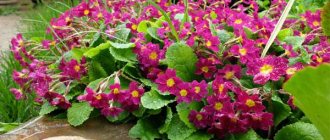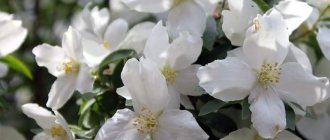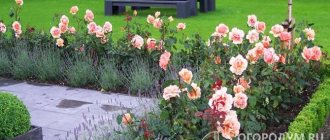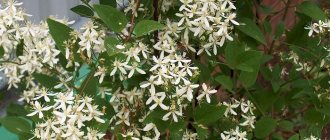Decorative hosta foliage will decorate any flower garden. Hostas go well with perennials, annuals and conifers. I developed an interest in these plants a long time ago, but never had the opportunity to use them on my site. And now, when I am faced with the task of creating a flowerbed from scratch from perennials, this plant seems irreplaceable to me. Why will I use hosts:
- Decorative foliage will dilute fresh perennials that have not yet gained strength.
- The plant will add volume to the new flower garden.
- It is possible to receive planting material for free (relatives:).
I understand perfectly well that hosta seedlings also need time to begin to please the eye. But this flower garden is more like a long-term plan. I am thinking through the scheme so that in the future I will get an attractive and well-groomed flower bed.
Something like this
And this requires more than one season. Still, perennials take a long time to reveal their power and beauty.
I want to implement the following flower bed scheme with hostas and other perennials.
And now more about the plant, so as not to make a mistake with the place of sale, soil preparation, and choice of varieties.
Landing place
Hostas should not be planted in full sun; there should be partial shade. Where the area is illuminated from 12 noon to 5 pm, it is better not to place these plants. I’m planning a place for a flower garden on the north side of the house, and it provides good shade. The sun is there only a couple of hours after sunrise in the morning and only a little bit in the evening. In open areas of the hosta, the foliage fades, the contrasting border fades, and burns appear.
Trees or shrubs growing nearby can also provide partial shade. Constant dense shade will also not benefit the plants. In spring, the ground in such areas takes longer to warm up, as a result of which the development of new shoots is inhibited. And flower stalks may not form at all.
Preparing the plant for winter
In order for hosta plantain or any other to successfully survive the cold, the following care is necessary:
- Remove all flower stalks.
- Divide the hosta if necessary. You can replant the bushes until mid-September.
- In the south, in central Russia, it is not necessary to cover the hosta. In dry weather, you can only mulch the soil with leaf soil, mown grass, dry peat, rotted sawdust or pine needles. You can sprinkle tobacco dust or “Fitosporin” on top to protect the flower from slugs.
- If you live in the northern region, after mulching the soil, cover the bush with a breathable heat insulator - agrofibre or spruce branches.
Soil preparation
Small deviations in soil composition from the ideal are unlikely to noticeably affect the appearance. Hostas are fairly unpretentious plants. But there are some recommendations from experienced gardeners:
- The composition of the soil is light loam, neutral, slightly alkaline or slightly acidic. Nutritious and well-drained soil. It is important to maintain moist soil, but at the same time avoid stagnation of water; it is better not to plant a swamp.
- It is advisable to add moisture retainers to sandy soil - peat, humus, compost. It will not be superfluous to mulch the plantings.
- Clay soil is diluted with fine gravel, organic matter with coarse fiber, and good drainage is provided.
- Avoid alkalizing the soil. Apply acidic peat and neutralize the alkali using other means. Yellowing leaves and loss of brightness will indicate that the plant needs acidification.
- On the unflooded shore of a reservoir, most hosta varieties reveal all their beauty. Increased humidity promotes the development of decorative foliage and helps to gain strength faster.
Top dressing
If, after planting in the spring, fertilizers are applied, then by the end of the season the hosta will delight with strong, rich foliage. You can judge the lack of substances necessary for the plant by its appearance: the bush withers, the leaves turn yellow and become smaller.
The first feeding should be done in the spring during the transplanting period or after the greenery blooms. The second is during the period of bud setting, the third is after flowering.
Tall hostas can be fed by adding peat or humus. They form a mulch layer and protect the shoots from drying out. In species with low bushes, such mulch causes stem rotting.
Planting in open ground
A seedling with 2-3 buds and a healthy rhizome with elastic roots 10-12 cm long is suitable for planting. Hostas tolerate replanting well, but it is better to do this in cloudy weather in the fall.
- For a medium-sized seedling, prepare a hole approximately 30*30cm, and lay drainage on the bottom.
- Compost, peat and complex fertilizers are added to the soil (no more than 50 grams for this volume of depression).
- The plant is placed in a prepared hole, the roots are straightened and covered with soil. Tamp down a little and water.
- The ground around the plant is mulched with bark or peat. The root collar is not deeply buried, maximum 1-2 cm.
- There should be at least 50 cm between seedlings.
Watering: how not to make a mistake
Hosta is a moisture-loving plant and thrives in slightly moist soil. But, thanks to its well-developed root system, it is able to endure short dry periods without harm.
The condition of the soil must be carefully monitored; it should be slightly moist. The fact is that large leaves intensively evaporate moisture, and if there is not enough moisture in the soil, the plant will slow down its growth. Recommendations on how to properly water hostas include not only the frequency, but also the method of watering.
Proper watering of hostas Source retete-usoare.eu
Inexperienced owners often make the mistake of watering bushes from above, along the leaves. Water rolls down the large leaves like an umbrella and is absorbed far from the plant, while the soil near the rhizome remains dry. In addition, water can remain in the rosette of leaves, causing rot, and attracting slugs and snails. Experienced gardeners have developed the following rules for watering hostas:
- The bushes are watered at the root, with a stream without strong pressure, so as not to wash away the soil at the rhizome.
- An adult bush requires up to 10 liters of water; as a result of watering, the soil should be moistened by 10 cm. After watering, the soil is loosened to improve water access to the roots.
- The regularity of watering depends on the moisture content of the soil. In a wetland, it will not be needed; near a pond, watering will be rare; in sunny areas, it is needed once every few days. If there is not enough water, the hosts will signal this: the leaves will darken at the ends.
Periodic feeding during watering will help maintain the brightness of the leaves Source hosta.discus-club.ru
How to care
Caring for a hosta is no different from the standard: timely watering, regular loosening of the soil, applying fertilizer, pruning shoots after flowering and mulching.
Watering
After planting in open ground, it is necessary to water every 3-4 days if there is no rain. It is advisable to maintain this regime until a new leaf appears. Then water as needed, only in the morning; evening watering is excluded. If there is a prolonged drought, it is necessary to moisten the soil daily, at the root, avoiding water getting on the foliage. The optimal solution is drip irrigation; it is provided for at the site planning stage.
Loosening
If we do not mulch the soil, then loosening should be carried out regularly, while simultaneously removing weeds. It is advisable to do this after watering.
Top dressing
It is permissible to carry out several feedings per year. In the spring, before the leaves appear, nitrogen-containing fertilizers are applied; they contribute to the growth of green mass. The second feeding is carried out in mid-summer. during the flowering period with potassium-phosphorus preparations. The next feeding occurs at the end of August, using organic fertilizers, for example, mullein solution.
Trimming
It is mandatory to prune flower stalks immediately after flowering. If you do not plan to collect seeds. Damaged sheets - burnt or diseased - should be removed as soon as they appear. To stimulate the growth of dormant buds for the purpose of subsequent division of the bush, the foliage is mowed completely.
Mulching
For hostas, mulching the root zone is mandatory. This will help retain moisture and prevent the soil from crusting over. To do this, use pine needles, crushed bark, and peat. This creates almost ideal conditions for slugs under the hosta foliage. Therefore, we will prepare to fight them, periodically shake up the mulch and eliminate uninvited guests.
What to do after planting hostas
In general, growing an ornamental deciduous perennial rarely causes difficulties, because the plant is unpretentious.
For the well-being of a perennial ornamental deciduous plant, after planting the rhizome in the spring, provide proper care (in general, it is especially important in the first year):
- It is necessary to water the garden functions regularly and in a timely manner. It is necessary to keep the soil moderately moist. Moisture is necessary for normal rooting. It is especially important to water regularly for the first two weeks.
If the soil settles a few hours after watering, you need to fill the soil to the previous level.
- It is recommended to mulch the area around the seedling immediately after planting (a layer of about seven centimeters). Mulch will delay the evaporation of moisture and protect against the formation of an earthen crust that prevents the normal supply of oxygen to the roots.
- For convenience, you can nail a peg next to the plant with the name of the species or variety (this element is relevant when planting a large number of seedlings of different varieties).
- If you have prepared the site or filled the hole with fertilizers, there is no need to feed the funkia for the first 2-3 years.
- Also, in the future, it is necessary to promptly remove weeds around the perennial.
This is how the planting of a wonderful culture takes place, which is deservedly called the “Queen of Shadow”. Particular attention should be paid to storing the material (so that it does not deteriorate, dry out or rot), as well as preparing the area, because its decorative qualities will depend on how comfortable the perennial is.
Reproduction
Hosta is grown from seeds or propagated by dividing the bush. Let's consider the features of these methods.
Growing Hosta from Seeds
This is a rather labor-intensive process. From the moment of sowing the seeds to the decorative appearance, at least three years will pass. Growing stages:
- Seeds are collected in September after ripening. We focus on the color of the seed pod - it should turn brown.
- Next, the collected material is cleared of debris and dried, placing it in a thin layer on a horizontal surface. In winter, the seeds are stored in a cool, dark, dry place.
- In the spring, before planting, they are soaked in a growth stimulator. Prepare nutritious soil, which is pre-disinfected by calcination or treatment with potassium permanganate. The soil is placed in pots or containers no more than 12 cm high that have drainage holes. Drainage is laid at the bottom, then a layer of nutrient soil. Next, moisten it and distribute the seeds. Cover the top with a small layer of soil - 0.5-1cm.
- Containers with future seedlings are placed in a warm place, but not in direct sunlight, away from radiators and drafts. Cover with film or glass until shoots appear. Next, monitor the soil moisture; it should not be overdried or waterlogged. It is better if watering is carried out through a tray.
- When the first leaves appear, you should pick. Once it becomes clear that the plant has tolerated the picking well, hardening can begin. To do this, the host is taken out for a short time to a balcony or street where there are no drafts. In July it is already possible to plant in open ground, avoiding strongly lit places. Otherwise, the plant will quickly burn in the sun. Let these be shaded areas or a place where the sun appears only in the morning.
Propagation of hostas by dividing the bush
Starting from the fourth year of the plant’s life, the adult hosta can be divided for propagation. The best time for this procedure is spring. Although the hosta can easily tolerate transplantation throughout the growing season.
- The hostas dig up the ground around them. The bush is lifted using a garden fork as a lever. Then the roots of the plant are placed in a solution of potassium permanganate and inspected for the presence of pests - slugs and snails. .
- Using a sharp instrument treated with an antiseptic, the hosta is divided into bushes according to their growth points. Rotten and dry roots should be removed.
- Next, a planting hole with drainage and fertilization is prepared for each plot. Cuttings are planted, compacted and watered, and mulched.
Hosta seedling (rhizome): how to select, preserve, prepare
Funkia is a fairly popular garden crop in our country, so it can be purchased in various centers and stores. It is most convenient to plant the hosta rhizome; most often it is sold in bags with a nutrient substrate (example in the photo below).
A high-quality funkia rhizome must meet the following requirements:
- The rhizome should have two or three growth buds (or at least one, no less)! However, such buds should not be overgrown.
- There should be a well-developed root system, the normal length of the roots is about ten centimeters.
- In this case, you should choose specimens with living, elastic roots.
- There should be no traces of mold or rot on the hosta rhizome, and it should not be dry.
- Also, the rhizome should not be too moist (that is, drops of condensation should not be visible on the packaging).
It is recommended to study the characteristics of the plant before purchasing. This will help you decide which variety is right for you.
It can be found on sale with a closed root system (in the photo below).
Rhizome processing
Before planting hosta rhizomes in open ground or in a pot for temporary storage, it is important to prepare planting material.
First of all, you need to carefully examine the seedling. If you find rotten, moldy, dead, diseased areas on the roots, they should be trimmed with a sharp, disinfected knife. After this, be sure to disinfect with a fungicide.
Also, roots that are too long should be trimmed a little , the cut areas should be powdered with wood ash or soaked in a fungicide.
In any case, it is useful to disinfect the rhizome by soaking it in a fungicide (for example, treat it in a solution of Fitosporin-M).
If the roots are too dry and look lifeless, then as a preparation it is useful to soak them in a solution of a growth stimulator (for example, Epin or some other).
How to preserve rhizomes before planting
Already at the end of winter or at the beginning of spring, planting material of this plant can be found on sale. Many summer residents and gardeners buy it in advance. If you are one of them, then you need to take care of storing hosta rhizomes after purchasing and before planting in open ground.
To store the rhizome, it should be planted in a temporary container.
The pot should have a volume of about one or two liters, and there must be drainage holes at the bottom of the container.
Soil for temporary planting can be used universally for seedlings, or you can make it yourself (mix non-acidic peat, sand, leaf or turf soil in equal proportions).
You can plant funkia rhizomes for temporary storage using the following technology:
- Place a 2-3 centimeter drainage layer (for example, expanded clay, perlite) on the bottom of the container.
- Fill the pot with soil, make a large hole the size of the rhizome.
- The rhizome should be planted in such a way that it fits normally in a pot of soil and the roots do not bend.
- The tip of the rhizome should remain slightly on the surface of the soil.
- Afterwards, generously water the soil with clean water. It is advisable to spill the soil with Fitosporin solution after plain water.
- It is advisable to sprinkle the surface of the soil in the pot with soil to avoid the appearance of an earthen crust.
To prevent the plant from starting to grow too intensively, it is recommended to place it on a northern windowsill or simply in a place with diffused light. It is also advisable that the place be cool enough.
Before planting hostas in open ground, the soil in the pot should not be allowed to dry out. If necessary, watering must be done. However, you need to water very carefully; the soil should be slightly moderately moist.
Note! Two weeks before planting, it is recommended to harden the rhizome; to do this, place the container outside, starting with a short period of time.
If you do not have the opportunity to plant the rhizome in a temporary container, you can put it in the refrigerator. However, they can only be stored in refrigeration if the kidneys are at rest! However, this storage method is bad because if the planting material is left in the refrigerator for a long time, it can rot.
Varieties
Hosta has a wide variety of species, among which there are the most suitable options for growing in open ground.
White-edged
Hybrid with medium-sized broad-lanceolate leaves. It has rich shades of green mass with a white border. This gives the plant an elegant appearance. It blooms in mid-summer with small purple flowers.
Bloated
A dark green hosta with glossy leaves. The bract has a wide heart-shaped shape. It blooms with lilac or purple flowers on an erect peduncle. The color of the flowers will be lilac. The sheets are uneven, with small waves.
Ovoid
Notable for the round shape of the bushes, the green leaves are ovoid in shape. The peduncle can reach 50 cm. It blooms with lilac-blue flowers. The leaves of some varieties may have yellow stripes.
Wavy
A hybrid variety of hosta. The bract has an oblong, ovoid, wavy shape, with white inclusions in the center. The flowers resemble a bell and are purple in color. Blooms in mid-summer. Varieties of this species are represented by crops with green foliage with a white stripe or a light center.
Siebold
The bract has a combined heart-ovate shape. The leaves have a waxy coating on the surface. Blooms with pale lilac flowers. A popular species among gardeners, varieties and varieties also come in shades of grey, dove or blue. Siebold is very often used as a mother plant for breeding work; new varieties of perennial are bred.
Fortune
An artificially bred variety. Externally, the plant is similar to the previous species, but smaller in size. The heart-shaped bract has a waxy coating. When flowering, there are many funnel-shaped bells on the peduncle. Painted in purple shades. It blooms in late summer and includes several varieties of different leaf color and bract size.
Curly
The heart-shaped leaves of this hosta grow up to 16 cm in length. The peculiarity lies in the different colors of the outer and inner sides of the leaf: the bottom surface is glossy, the top is matte green, and the leaf has a white stripe along the edge. The flower stalks are long and clearly visible in the dense foliage. The inflorescence contains 30-40 flowers, 4-5 centimeters long. Petals are lilac with yellow anthers. It blooms in late summer and has a slow growth rate.
Lanceolate
The bract of this hosta is lanceolate-ovate, rich in color, with brown inclusions. The color of the flowers is purple with dark stripes. It blooms late and decorates the flower garden until late autumn.
Podorozhnovaya
The leaf also has an ovoid shape with a glossy surface. Dense flowering occurs in mid-summer. White bells with an unobtrusive aroma.
Erectifolia
This hosta can form a dense, dark green shrub with foliage growing vertically from the ground. It blooms with purple flowers throughout almost the entire summer.
Hosta flower - description
Hostas are herbaceous perennials with a short rhizome, petiolate leaves, varied in shape, color and texture and forming a basal rosette, and racemose, often one-sided inflorescences of lilac, purple or white funnel-shaped or bell-shaped flowers, located on tall, weakly leafy peduncles. In some species, flower shoots can reach 120 cm. The fruit of the hosta is a leathery triangular capsule with flat, black, winged seeds. Hostas are long-lived even among perennials: unlike other plants, their rosettes become more magnificent and beautiful over the years and retain their decorative appearance for up to 25 years or more.
Classification
There are several groups based on the external characteristics of both wild and hybrid species. The gradation of plants depends on size. According to the American classification, the following groups can be distinguished:
- dwarf - height does not exceed 10 centimeters;
- miniature – grow up to 15 centimeters;
- small - plants up to 25 centimeters;
- medium - grow up to half a meter;
- large – these hostas can reach 70 centimeters in height;
- gigantic - over 70 centimeters.
There are hosts that belong to intermediate groups of this classification.
In addition to size, the following features may be taken into account:
- leaf shape – round, oval, elongated, heart-shaped;
- type of leaf surface - corrugated, matte, glossy, wavy, bronze-metallic;
- green color – white, golden, gray and blue shades, deep green.
Variety of hybrids
Hostas are plants that can cross-pollinate (receive foreign pollen). Thanks to this property, to date, breeders have developed more than 4,000 varieties and hybrids that remain decorative from spring to autumn. It is convenient to classify all this diversity according to the following criteria:
- According to the height of the bush . Dwarf varieties grow 16-25 cm, giant varieties - 70-80 cm.
- According to the leaf shape . The shape varies from narrow lanceolate to broad ovoid (rounded) with intermediate oval and heart-shaped variants.
- By color . Breeders managed to achieve a significant variety of colors: these are all shades of green, blue, yellow, variegated (with a border of a different color, yellow, white, cream). There are three-colored hostas, chameleons that change color several times a season, and three-colored varieties.
- According to the texture of the sheet . The surface of the sheet can be smooth, glossy or matte, waxy, velvety, with deep veining, and a waffle texture.
Hybrid with three-color leaf color Source botanichka.ru
Popular varieties and types of hosta with photos
White feathers
One of the best varieties with white young leaves. As it grows, the veins turn green, and then the rest of the leaf. The size of the leaf plate is about 15x5 cm. It blooms in June-August with lilac leaves. Peduncles can reach 60 cm. The height of an adult plant is about 40 cm. It tolerates frosts down to -35°C, so it is suitable for most regions of Russia.
Gold standard
Large ovate leaves. The leaves are soft green with a dark green border and change their color to golden over time. They are about 25 cm long. It blooms in July-August with light lilac flowers. An adult hosta grows up to 70 cm in height and up to 120 cm in width. This should be taken into account before planting in a permanent location. Belongs to frost-resistant varieties.
Bright groom
The variety is distinguished by heart-shaped leaves, curved in an arc and a strongly wavy border. The bush is shaped like a fountain. It blooms at the end of summer on a peduncle about 45 cm high. A medium-sized plant up to 40 cm in height, up to 85 cm in diameter. Frost-resistant variety suitable for the climate of Moscow and the Moscow region.
Malachite Box
The leaves have a rounded shape and multi-colored lines - from malachite to milky green, measuring 20*30 cm. It blooms with white bells in July. Grows both in partial shade and in illuminated areas. The variety is frost-resistant, suitable for most regions of Russia.
Avocado
Large, fast-growing hosta with dense and convex leaves. Bright green in the center and darker at the edges. The similarity of shape and color with avocado gave the variety its name. Blooms with large bell-shaped flowers in August. Reaches 70 cm in height and 120 cm in width. It can be grown in the Urals, as it tolerates frosts down to -40 degrees.
Blue Angel
The fast-growing giant hosta has fluted leaves with a blue tint. Blooms in July-August with white flowers. It is resistant to diseases and pests. It can reach a height of 120 cm. Suitable for growing in regions with a temperate climate, tolerates frosts up to 35 degrees.
Atlantis
A hybrid variety growing up to 80 cm in height and up to 170 cm in width. It has a dense, bright green leaf plate with a wide border of yellow or cream color.
Antiochus
A medium-sized variety with powerful green leaves edged with a creamy white stripe along the edge. Blooms in June with lilac flowers.
August moon
It has large heart-shaped leaves from yellow-green to golden color. Grows up to 50cm in height and up to 1 meter in width. Blooms in July-August with pale lavender flowers. The variety is frost-resistant, tolerates temperatures down to -40 degrees.
Albomarginata
Hosta Albomarginata is suitable for growing by beginning gardeners. It has a dense bush up to 60 cm in height and up to 1 meter in width. The leaves are grooved, dark green with a white edge. Blooms with purple flowers. The ideal place for growing will be partial shade; it is not demanding on the soil. Overwinters at temperatures down to -35 degrees, resistant to pests and infections.
T. Rex
T Rex is a variety of giant hosta that reaches 120 cm in height. Suitable as an accent plant for a flower bed. The leaves are green, with pronounced veining. Blooms with white flowers in June-July.
Albopicta
It has large heart-shaped leaves, a dome-shaped bush, light green with a green border. Grows up to 70 cm in height and up to 1 meter in width. Blooms in mid-summer with lilac or blue flowers. Frost-resistant variety, reaches its greatest decorative value by 5 years of age.
Lipstick blonde
A very bright representative with rich yellow foliage on red stems. Medium height - up to 40 cm in height and up to 50 cm in width. Blooms in July with lavender flowers.
Blue ivory
The dense, heart-shaped leaves have a blue tint with a creamy edge. The bush grows low up to 50 cm, but can reach 1 meter in width. The brightest color appears in the shade and partial shade. It will look impressive as an accent in a flower bed or surrounded by a lawn.
Mouse ears
The leaves are dense, blue-green in color and have a slightly rounded shape. Refers to miniature species, no more than 20 cm in height. Hosta mouse ears has several varieties, slightly different in leaf shade and shape. It blooms with lilac or white flowers collected in racemes.
Brim Cap
Compact kut with small grooved cup-shaped leaves with a wide cream-colored border. Blooms in July-August with purple flowers. The height is small, up to 35 cm. It is a frost-resistant variety and tolerates frosts down to -35 degrees.
Proper care of hosta
Hosta is unpretentious. Even a novice gardener can plant and care for it in open ground. It is the ideal solution for the garden of busy people. The main thing is to choose the right place, varieties suitable for the climate, and pay very little attention to it during the season.
Top dressing
Every fall, it is recommended to mulch the soil around the bushes with a layer of 5 cm of leaf soil (maybe less for dwarf and miniature ones). You can add a little tobacco dust from snails and slugs and Fitosporin to the mulch as a preventive measure against fungal diseases.
Autumn mulch is especially relevant for specimens growing near trees. This is necessary so that they do not lack nutrition, since trees absorb a lot of nutrients.
How to feed hostas in spring for lush flowering in the garden
| Power supply | How to deposit |
| The main source of nutrition is organic matter (leaf soil, compost, rotted bark, etc.) | Applying it under the bushes in the fall in the form of a 5-centimeter layer of mulch will provide favorable conditions for the life of microorganisms and worms that increase fertility. |
| Mineral fertilizers | Liquid The proportional ratio: nitrogen (N) / phosphorus (P) / potassium (K) in the host version should be 1:1:1 or 1:2:1.
|
Granular
In both the first and second cases, the amount of fertilizer is applied according to the instructions. Encapsulated long-acting fertilizers (such as Osmokot) are also good. |
Trimming
If an ornamental perennial on a site is grown for its luxurious leaves, and not for its flowering, it is better to break out the young flower stalks. Firstly, their appearance leads to the “collapse” of the bush. Secondly, the need for additional moisture increases. In varieties with large, beautiful, fragrant flowers, peduncles should be cut off immediately after flowering.
In the fall, trim off yellowed leaves (it is advisable to do so before the first frost).
Diseases and pests
Hosts practically do not get sick. The most common disease is gray mold. Viral diseases are rare, but still occur. They appear in uncharacteristic variegation, speckles, and ring spots. Their treatment is:
- treatment with special preparations and regulation of soil moisture (not waterlogged) - for the treatment of gray rot;
- removal and destruction of diseased bushes - to combat viruses.
Most often (especially varieties with thin leaves) they are affected by slugs and snails. Control measures:
- bait - rags, beer;
- hand picking is the most reliable method;
- purchasing slug-resistant varieties.
Less commonly affected by leaf nematodes.
Wintering hostas
In general, the hosta is hardy and winter-hardy. However, it is worth considering that not all varieties are equally suitable for central Russia, and even more so for growing in Siberia and the Urals. Another danger is posed by return frosts.
Lowering temperatures to -4°C after foliage appears can lead to frostbite and dehydration.
Preparation for wintering involves mulching with organic matter and covering areas with spruce branches or brushwood.
It is strictly not recommended to cover with polyethylene, roofing felt, or similar materials.
When does hosta emerge after winter? The spring regrowth of leaves, emerging rolled into a cone or tube from the ground, begins with the onset of stable warmth - approximately from mid-April (later for some varieties). After a few weeks, the leaf plates unfold, taking on characteristic shapes.
If the onset of heat is delayed, the hosta may not sprout for a long time during the winter. As a rule, there is no point in getting upset, panicking or digging up the clumps prematurely. Exotic varieties and specimens growing in the sun begin to grow much later, sometimes by the beginning of June.
Other reasons for lack of germination:
- freezing in open ground is not a winter-hardy variety for the region,
- getting wet,
- non-compliance with agricultural cultivation techniques,
- “overfeeding” during the growing season,
- cutting leaves too early, etc.
What to plant next to hosta in the shade
Hosta companions are plants that do well in shade or partial shade. You can plant next to the hosta:
- Astilbe - will decorate the flowerbed with its blooming panicles;
- Heuchera is an unpretentious plant with bright leaves;
- Fern - will decorate a flowerbed with carved foliage;
- Primroses - add color to the flower garden in spring;
- Hydrangea - to form a bright multi-tiered flower bed.
Hosta with astilbe
Hostas with heucheras
Hosta with fern and ivy
✅ Where is the best place to place the plant?
When choosing a location for the hosta, you need to consider the following factors:
- The area should be moderately damp.
- The place should be in a windless area.
- It is impossible to plant hosta in through areas, but strong stagnation of air is not suitable either.
- You cannot grow a flower in places where moisture stagnates.
- During the hottest time of the day, the area should be in the shade.
- Depending on the variety, lighting requirements may vary.
What to plant next to hostas in the flowerbed, along the fence and path
If you are designing a path along the edges of which you plan to plant hostas, then choose plants of the same variety. It is desirable that these be low-growing varieties. After planting, you need to be patient; the paths bordered by hostas will acquire a decorative appearance and completeness no sooner than after three seasons. You can complement the design with ground covers. Hostas - coleus in red shades will also perfectly complement the greenery. To make the hosta border look more picturesque in the spring, plant low primroses between them: crocuses, hyacinths, muscari.
Hosts along the tracks
When forming a composition along the fence, you can combine hosts with daylilies, irises, astilbe, and roses. In this case, it is necessary to observe tiers. Plan in advance the planting of plants in such a way that the decorative value of each of them is visible to your eye: low-growing plants in the foreground, behind them medium-height ones, and in the background - the tallest ones.
Hosta with hydrangeas
About the hosta's habits
The perennial, which is related to the lily of the valley, received its name in honor of the Austrian botanist N. Host. The plant, widely used in landscape design, is interesting for the following features:
- In the wild, hosta (about 40 species) grows in the moist, shady forests of Japan, China and Korea.
- The main advantage of the culture is considered to be large, elegant leaves. But its funnel-shaped or funnel-shaped bell-shaped flowers, collected in racemes or spike-shaped inflorescences, are also attractive.
- In nature, hostas are found mainly along the banks of streams or rivers, on shady edges. But they also grow on mountain slopes and tolerate drought quite easily. It is worth paying attention to these preferences when choosing a place to plant the hosta on the site.
The perennial herbaceous plant has found a place in gardens, parks and summer cottages, not least due to its unpretentiousness; Even a beginner can grow a hosta. However, it will look impressive only if certain growing conditions are met.
Decorative combination of several varieties of hosta Source vechorka.ru
Examples of using hosta in landscape design - photos
Hostas in front of the house
Flowerbed with hostas
Hostas by the pond
Contrasting combinations with hosta
Hosta in the recreation area











